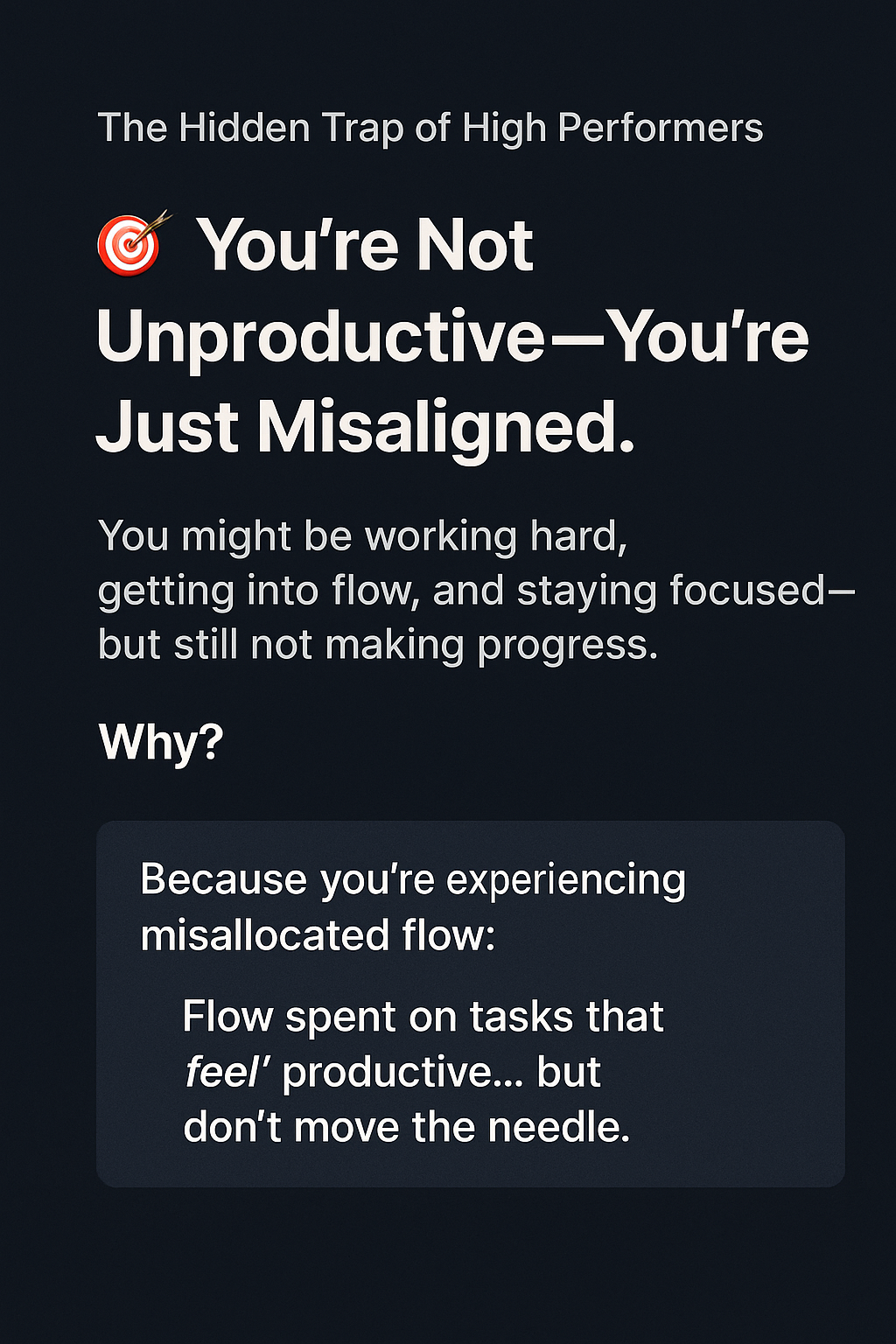How a single skill determines whether you’ll achieve your goals or stay perpetually busy
Ever feel like you’re working hard, getting into deep focus, even hitting flow—but somehow still not making meaningful progress?
You’re not alone.
Many of the most driven people on the planet fall into what Rian Doris calls “misallocated flow”—a silent productivity trap where you give your absolute best effort… to the wrong things.
Misallocated flow is being in the zone—on the wrong task.
The Hidden Trap of Misallocated Flow
Misallocated flow state is the experience of being deeply focused and in the zone but aimed at tasks that have no direct link to your goals. It’s the invisible productivity trap where you feel your best and perform at your best yet move nowhere meaningful.
This is particularly insidious because it feels like progress. You’re working hard, staying focused, even achieving flow states. But flow without direction is just speed—what we need is velocity, which is speed plus direction.
Think of it as having a Ferrari but driving it in circles instead of toward your destination. The engine is powerful, but the targeting system is broken.
Goal-Directed Spectrum
The goal-directed spectrum measures how precisely your moment-to-moment actions align with your long-term goals. It’s the single skill that determines whether you’ll achieve your objectives or stay perpetually busy without real progress.
Low on the spectrum: You have goals but frequently get pulled off course, falling victim to feeling productive while making no real progress.
High on the spectrum: Almost everything you do gets you closer to what you really want. Your actions are determined almost exclusively by your goals, regardless of what’s happening around you.
It’s the difference between being a leaf in the wind (constantly fluttering, busy but directionless) and a heat-seeking missile (moving less in total distance but hitting the target with precision).
The Neuroscience Behind Goal-Directedness
Research by Bernard Balleine and John O’Doherty reveals that our brains have two different systems for controlling actions:
- Stimulus-response system: Fast, automatic, built for energy conservation. See notification → check it. Hear ping → react to it. Get bored → switch tasks.
- Action-outcome system: Calculates the relationship between what you do and what results you get. Constantly evaluates: “If I do X, I will achieve Y.”
Most people default to the stimulus-response system, reacting to whatever comes along with no internal compass. Peak performers operate primarily from the goal-directed action-outcome system, maintaining laser focus on outcomes.
The researchers describe goal-directedness as “one’s sensitivity to the relation between the action and the outcome.” It’s your sensitivity to how your current actions will drive the future outcomes you’re pursuing.
The Four Sub-Skills of Goal-Directedness
Goal-directedness isn’t just prioritization—it’s a meta-skill composed of four distinct abilities:
1. Goal Clarity: The ability to set a clear long-term goal. Without this, every task looks equal, and every distraction becomes justifiable. The fewer goals you pursue simultaneously, the more goal-directed you become.
2. Action Identification: The ability to identify which actions will directly move you toward your long-term goal. This is about spotting causal chains—seeing the exact sequence of actions (A→B→C→D→E) that leads to your desired outcome.
3. Prioritization: Putting goal-directed actions first, always. When you’re highly goal-directed, this becomes easier because you have a clear filter: “What moves me closest to my goal faster than anything else?”
4. Strategic Neglect: The discipline to completely ignore everything other than goal-directed actions. This means saying no to good opportunities so you can say yes to great ones.
Optimization vs. Good Enough Tasks
One critical distinction that enhances goal-directedness is understanding the difference between:
Optimization tasks: Require continual refinement because small improvements yield exponentially greater results.
Good enough tasks: Once you hit a certain threshold, additional refinement provides no significant gain. Going from 80% to 100% creates minimal additional value. Most tasks fall into this category.
A heat-seeking missile doesn’t optimize its trajectory for beauty—only for impact. Save your obsession for the few things where perfection actually compounds.
Three Systems for Operational Goal-Directedness
Based on research across thousands of high performers, here are three simple systems to achieve high-level goal-directedness:
The Goal Stack
Create a one-page visual hierarchy that maps your vision to 5-year goals, then to 1-year, quarterly, monthly, and weekly goals. This becomes your “minute-to-decade alignment map.”
The Goal Flywheel
Weekly (Sunday evening preferred), review your goal stack and identify 3-5 actions for the coming week that would most directly advance your monthly and quarterly goals. Schedule these before anything else gets added to your calendar.
The Power Down Ritual
End each workday with 30 minutes focused on: identifying tomorrow’s 1-3 most goal-directed actions, clearing open loops with quick decisions, and mentally disengaging from work for recovery.
These systems require minimal time investment but create maximum return by making goal-directedness automatic rather than requiring constant willpower.
The Ultimate Test
Here’s a litmus test for your position on the goal-directed spectrum:
Imagine someone walks into your office right now and demands: “What is the single most goal-directed action you should be doing right now?”
Could you answer instantly with full conviction and clarity, or would you fumble?
Truly goal-directed performers can answer this question at any moment—for the day, week, month, and quarter. They know exactly what moves them toward their long-term goals because it’s the most top-of-mind thing in their awareness.
If you can’t answer this in seconds, your most goal-directed action becomes obvious: pause everything and figure out what your goal-directed action actually is.
The Compound Effect
Goal-directedness is probably the single biggest lever on your output. When you operate at the high end of the spectrum, you can accomplish in focused strategic hours what others take weeks to do.
This means you can either achieve far more at the same time or maintain your current output while dramatically improving work-life balance. Peak performers aren’t busier than you—they’re just clearer about what’s worth doing and what isn’t.
The goal-directed spectrum explains why some people seem to effortlessly pull ahead while others stay perpetually busy but make no meaningful progress. It’s not about working harder—it’s about working with precision on the right targets.
Your position on this spectrum, assuming basic talent and skill, is one of the clearest predictors of peak performance. How dialed-in your targeting system is makes all the difference.
The choice is yours: remain a leaf blown by the wind of circumstance or become a heat-seeking missile locked onto your target. The difference lies not in how hard you work, but in how precisely you aim.
